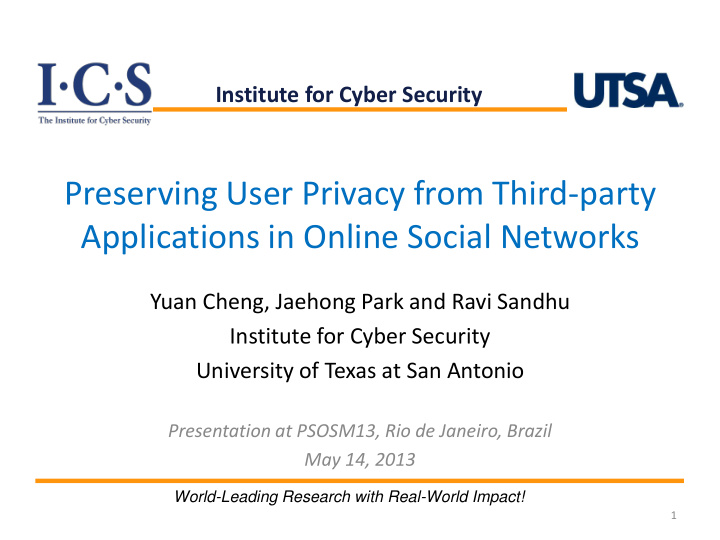



Institute for Cyber Security Preserving User Privacy from Third-party Applications in Online Social Networks Yuan Cheng, Jaehong Park and Ravi Sandhu Institute for Cyber Security University of Texas at San Antonio Presentation at PSOSM13, Rio de Janeiro, Brazil May 14, 2013 World-Leading Research with Real-World Impact! 1
Agenda • Privacy Issues of 3 rd -party Apps • Countermeasures • Access Control Framework • Policy Model • Conclusions World-Leading Research with Real-World Impact! 2
Privacy Issues • An all-or-nothing policy for application-to-user interactions – User has to grant the app full access, even if the app only needs partial data • Users are not aware of the application’s real needs World-Leading Research with Real-World Impact! 3
Privacy Issues (cont.) • Coarse-grained opt-in/out privacy control does not let user specify policies for each piece of data • Some permissions are given by user’s friend who installed the app, without user’s knowledge World-Leading Research with Real-World Impact! 4
Countermeasures Summary Pros Cons Data Generalization Convert private data to a Have been widely privacy-nonsensitive form accepted in recent solutions User-specified Allow user to express their Privacy Preference preference more flexibly Communication Intercept requests, exert Lose Interceptor user preferences, and return functionality and sanitized or dummy data integrity Information Flow Confine app execution and Enable post- Need substantial Control mediate information flow authorization modification to current architecture User-to-application Provide a complete policy Policy Model model for users to define, use and manage their own policies 5
Goal • Protect inappropriate exposure of users’ private information to untrusted 3 rd party apps • Propose an policy model for controlling application-to-user activities – More flexible • further utilize the relationships and the social graph in OSN – Finer grained • e.g., per resource vs. per resource type, distinction of different types of access World-Leading Research with Real-World Impact! 6
Framework Overview • Prevent applications from learning user’s private information while still maintaining the functionality • Leave private information within OSN system and allow external servers of applications to retrieve non- private data World-Leading Research with Real-World Impact! 7
Proposed Architecture World-Leading Research with Real-World Impact! 8
Application Components • Internal component – High trustworthy; can handle private data – Can be provided by OSN and 3 rd -party entities • External component – Provided by 3 rd -party entities – Low trustworthy; cannot consume private data World-Leading Research with Real-World Impact! 9
Communications OSN provided 3 rd -party provided Communication w/ system M1 M2 calls Communication w/ non- M3 M4 private data Communication between components only through OSN- specified APIs Communication w/ system calls Communication w/ non-private data Communication w/ private data (not allowed) World-Leading Research with Real-World Impact! 10
Relationship-based Access Control w/ Apps He didn’t install the app follow friend install colleague World-Leading Research with Real-World Impact! 11
Policy Specifications • <action, target, (start, path rule), 2 ModuleType > – action specifies the type of access – target indicates the resource to be accessed – start is the position where access evaluation begins, which can be either owner or requester – path rule represents the required pattern of relationship between the involved parties e.g., “install”, “ friend·install ” World-Leading Research with Real-World Impact! 12
Policy Specifications • <action, target, (start, path rule), 2 ModuleType > – action specifies the type of access – target indicates the resource to be accessed – start is the position where access evaluation begins, which can be either owner or requester – path rule represents the required pattern of relationship between the involved parties – ModuleType = { M1, M2, M3, M4, external }, 2 ModuleType indicates the set of app module types allowed to access World-Leading Research with Real-World Impact! 13
Example: App Request Notification • <app request, _, (target user, install), {M1, M2, M3, M4, external}> – For apps she installed; Protect her data • <app request, _, (requester, install∙friend ), {M1, M2}> – For apps she installed ; Protect her friends’ data • <app request, _, (target user, friend∙install ), {M1, M2}> – For apps her friends installed; Protect her data World-Leading Research with Real-World Impact! 14
Example: Accessing User’s Profile • <access, dateofbirth, (owner, install), {M1, M2}> – DOB is private • <access, keystroke, (owner, install), {external}> – Keystroke is non-private – Keystroke information is crucial for fulfilling functionality • <access, emailaddress, (owner, friend∙install ), {M1, M2, M3, M4}> – Protect his friends’ data World-Leading Research with Real-World Impact! 15
Conclusions • Presented an access control framework – Split applications into different components with different privileges – Keep private data away from external components • Provided a policy model for application-to- user policies – Specify different policies for different components of the same application World-Leading Research with Real-World Impact! 16
Q&A Questions? ycheng@cs.utsa.edu http://my.cs.utsa.edu/~ycheng Twitter: @nbycheng World-Leading Research with Real-World Impact! 17
Recommend
More recommend